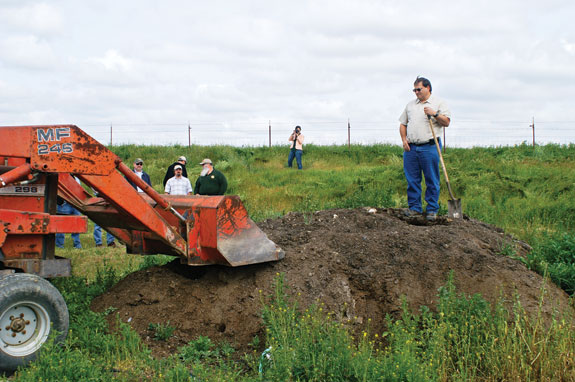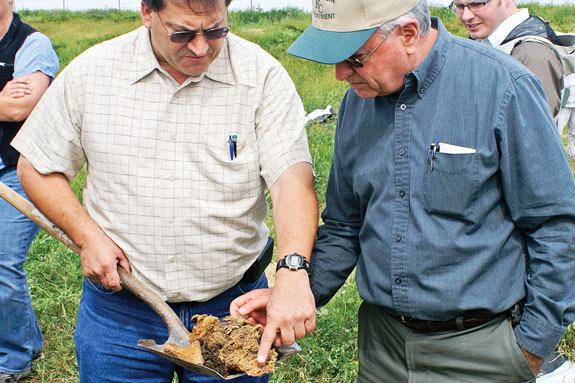This article was #8 in PDmag's Top 25 most-well read articles in 2010. Summary: A heat spell in California during the summer of 2006 caused the deaths of more than 20,000 cows. This incident spurred the industry to take a look at cow carcass disposal and begin a two-year cow composting project at the UC Veterinary Center. The article highlighted the opportunities available to producers if composting carcasses became legal. Because this article was so popular, we asked Jim Sullins of University of California Cooperative Extension a follow-up question:
Q. Is composting carcasses still illegal? Where is the process at?
A . At this time, composting mammalian tissue is illegal in California and in fact state law had to be changed just to allow the research to be done. The carcass composting studies were done to assess the viability of carcass composting as an emergency disposal tool, to evaluate pathogen reduction and develop an initial set of environmental safety parameters. The research team is in the process of submitting their data to the appropriate agencies who will assess the method as an emergency tool.
—Jim Sullins, County Director for University of California Cooperative Extension
ARTICLE

Options for disposal of dairy cow carcasses are limited in California and can lead to tough decisions for producers faced with a catastrophic event.
Several of those events have been realized in recent years. Statewide, the heat spell of July 2006 caused the deaths of more than 20,000 cows. Rendering plants were overwhelmed and many cows were buried in landfills.
Individual disasters on dairies and ranches have also left producers with the task of disposing dozens of cow carcasses. Annually, outside of disasters, 90,000 to 105,000 dairy animals die on-farm. The only legal disposal method is rendering.
Producers can pay a fee for mortality regular pick-ups, but an uptick in daily mortalities or a glitch in operations at one of the four rendering plants that handle dairy carcasses can throw off a precarious balance and lead to environmental concerns. Dead animals are usually shielded from public view, but if they can’t be picked up within hours, they are viewed as a threat to environmental safety.
“It’s a sensitive issue,” said Jim Sullins, director of Tulare County’s Cooperative Extension office. Odors and the potential for ground and surface water contamination are major concerns.
“The enormous carcass disposal crisis in 2006 was a call to action to look for alternatives,” said Sullins.
Sullins was joined in mid-March by University of California researchers, county agriculture officials and representatives from regulatory agencies for a look at a two-year cow composting project at the UC Veterinary Medicine Teaching and Research Center in Tulare.
Composting carcasses on-farm can be a viable alternative for dairies – if it becomes legal – Sullins believes. Tulare County, the state’s leading dairy county, has no local landfill options for emergency disposal. State regulatory agencies have cited health concerns, as well as air and water quality concerns, as reasons to restrict on-farm composting, but acknowledge that landfill burial, which was allowed in some counties during the 2006 heat wave, also poses environmental problems. Data from the composting research will be used by regulatory agencies considering alternatives for emergency carcass disposal.

The public health concerns with emergency carcass disposal led in 2008 to formation of the Emergency Animal Disposal Working Group by California Department of Food and Agriculture and the California Integrated Waste Management Board. About 100 stakeholder organizations are participating. Current projects include gathering landfill and rendering databases, as well as composting research. The California Environmental Protection Agency issued a special permit for the composting study.
Carol Collar, a UC dairy adviser in Kings County, said the composting study was designed to simulate on-farm conditions. Labor, equipment and availability of materials were taken into account. Researchers wanted to determine how well manure worked as a composting agent, quantify run-off and measure air emissions as well as the effect of weather. The study also evaluated pathogen reduction during the composting process.
The rate of decomposition, temperature inside the composting piles and weather conditions during the process were also recorded.
The study used both screened solids and corral scrapings as composting agents. Collar said the difference in the moisture content of each material was significant, with separated dairy manure solids at 57 percent and corral scrapings at 27 percent. Both worked equally well, however, as a carbon source necessary to fire the decomposition process. Guidelines from Kansas State University research set optimal moisture in the 40-60 percent range. Separated dairy manure solids were at 57 percent, but corral scrapings were at 27 percent. The compost piles had 16 by 24 foot footprints and were lined with silage cover material – another nod to on-farm material use. The carcasses were placed on a three-foot-deep bed of solids or scrapings and covered to a depth of three feet. Some piles were made without cows to determine if there were differences in air emissions.
In addition, piles were inoculated with surrogate pathogens to see if they survived the composting process. Perforated pipes under the piles drained the liquids from the decomposition process into barrels so the potential for leaching could be determined. Data loggers inside the piles recorded temperatures. Researchers also measured ammonia and volatile organic compounds released from the compost piles during the course of the study.
In states where composting is legal, land grant university researchers have developed information specific to their area for producers who want to compost mortalities. The California group sought similar data for Central Valley producers. On March 25, they revealed – or unearthed – evidence of a successful project.
UC researcher Paul Rossitto noted that the compost piles, over time, shrink by 50 percent. Other materials that can be considered for composting are silage and sewage sludge, he said, but they must be high in carbon, which generates the heat.
Preliminary results from the study showed that heating in the piles was rapid and prolonged, with temperatures exceeding Environmental Protection Agency requirements for Class A biosolids. At the cow level of the piles, temperatures of 120 degrees were measured for six months. Disease-causing bacteria were not detected after six to 10 weeks into the composting project. There was slight elevation in VOCs and ammonia emissions from the piles, Collar said, but totals were lower than emissions from green waste.
“Live cows produce more VOCs than dead ones,” said Collar.
In addition, extensive decomposition, 90 to 95 percent, was achieved within four months. Large bones were still visible, but they were showing signs of decomposition.
Located in an isolated area, the compost piles did attract some vertebrate pests, but Rossitto said they left the piles alone after three to four weeks. PD
Cecilia Parsons is a freelance writer from Ducor, California.
PHOTOS
ABOVE RIGHT: Paul Rossitto, a researcher at University of California Veterinary Medicine Teaching and Research Center in Tulare, stands atop one of the compost piles at a field day where stakeholders viewed progress on the cow carcass composting study. Originally more than nine feet in height, the piles were half that height at the end of the composting process.
ABOVE LEFT: Paul Rossitto, a researcher at the VMTRC in Tulare, and Tim Niswander, Kings County Agricultural Commissioner, note the rate of decomposition from a cow carcass that was composted in a study conducted at the Tulare site. Temperatures reached 120 degrees inside the piles and destroyed pathogens. Photos by Cecilia Parsons.






